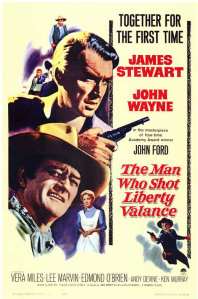 Starring Jimmy Stewart and John Wayne, this is one of John Ford’s later masterpieces. I love Ford because he brilliantly crafts stories, characters and cinematography in such a way that I come away not quite able to explain why I liked the movie so much. His craftsmanship is more subtle than Alfred Hitchcock’s and his movies not quite as epic as William Wyler’s. In an effort to understand why I like Ford movies so much I’ve actually started learning more about film. Not that I’m in danger of becoming a lofty film critic.
Starring Jimmy Stewart and John Wayne, this is one of John Ford’s later masterpieces. I love Ford because he brilliantly crafts stories, characters and cinematography in such a way that I come away not quite able to explain why I liked the movie so much. His craftsmanship is more subtle than Alfred Hitchcock’s and his movies not quite as epic as William Wyler’s. In an effort to understand why I like Ford movies so much I’ve actually started learning more about film. Not that I’m in danger of becoming a lofty film critic.
But back to The Man Who Shot Liberty Valance. The story opens with Senator Ransom Stoddard (Jimmy Stewart) returning to the town of Shinbone as an older man. It’s revealed he is there for the funeral of an old friend, Tom Doniphon (we later find played by John Wayne), who no one there seems to remember. Most of the movie is a flashback as Rance tells the story of him and Doniphon.
John Wayne is the tough, individualistic cowboy who carries justice on his hip, but is mostly content to live his own life while the weak are at the mercy of stronger men. Jimmy Stewart is the young lawyer recently come from the east to bring law to the uncivilized West. Stewart is almost contemptible in his physical weakness against the gun-toting outlaws, but admirable in his raw courage and tenacity. I could write quite a bit about how these avatars of their ideals play out in the movie and how the power (and love interest) shifts, but I won’t spoil it. Suffice to say, it’s beautifully done.
Even though we’re classifying this movie in the Classic Era, I think it’s what a revisionist film should be. It explores the genre deeply and movingly. It’s employs allegory to comment on, and even deconstruct, the western mythos and the movie genre that Ford helped create, though in a reverent – not careless – way. Neither main character is -as we see above – your typical western hero. The film was shot in beautiful black and white, even though color had all but taken over by 1962, but almost completely using sets, in contrast to Ford’s earlier sprawling epics. Much of the film even takes place in the crowded-feeling kitchen of a restaurant among dirty dishes rather than the typical western settings, such as the saloon-brothel. But it works.

I recently watched The Man Who Shot Liberty Valence a second time and was able to appreciate it even more. I didn’t get much deep meaning the first time I watched it (and I also know there’s still more to be appreciated if I watch it a third), but I still loved it that first time because it’s a just plain entertaining western. John Wayne is the epitome of coolness, authority, and presence. This is the John Wayne image I always had in my head – even before seeing this movie – from his cowboy duds, bandana, and low-hanging gun-belt to the way he calls Stewart’s character “Pilgrim”. Jimmy Stewart is his stereotypical self as he passionately rants for the ideals of law by the book and civil responsibility. One complaint I’ve read since is both actors were too old for their roles, but, though I myself had the thought initially, I quickly forgot it in the watching, as they are too perfect for what Ford is doing here.
The supporting characters are some of the most entertaining I’ve ever seen, with Lee Marvin as the cruel menace Liberty Valance himself, Vera Miles as the beautiful (but not seductive) love interest, Andy Devine as the cowardly marshal, Edmond O’Brien as the drunk but eloquent newspaper-man, Valance’s two polar-opposite henchmen played by Lee Van Cleef and Strother Martin, and many others. I love Ford’s cinematography as usual, from the amazing showdown in the street to my favorite shot of John Wayne standing completely in shadows until his brooding face is briefly illuminated as he lights a cigarette.
I think there’s something here for everyone, because it brilliantly balances the old and the new and treats them with respect. It is multi-layered, but offers just plain good entertainment.

